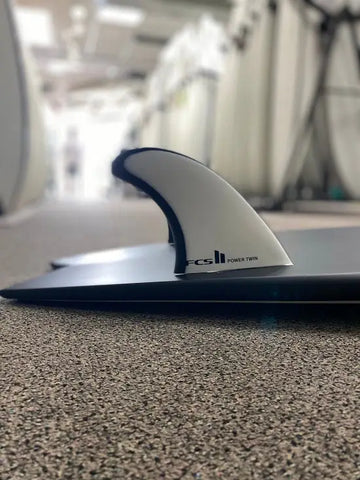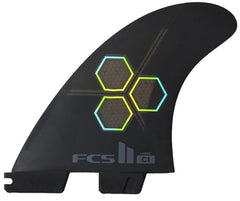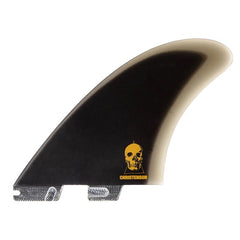How To Choose The Right FCS II Fins By Hawaiian South Shore
Share
FCS II Fin Clinic by Hawaiian South Shore
While much emphasis is put on the rocker, rails, volume, bottom contours, and the various other aspects of board design, fins are hardly ever discussed. And yet they might just be the most important part of a surfboard. After all, they literally allow us to steer our boards through barrels and turns!
Fortunately for those of us who like to experiment with different designs, removable fin systems make it easy to do. FCS has been a leader in the removable fin system market for decades, and the current FCS II collection features a variety of templates and constructions that work for a variety of different surfers and conditions.
|
|
||||||||||||||||
|---|---|---|---|---|---|---|---|---|---|---|---|---|---|---|---|---|
|
|
||||||||||||||||
 |
||||||||||||||||
 |
||||||||||||||||
FCS breaks its different fin designs into four families: Reactor, Performer, Accelerator, and Carver.
These families are differentiated by the rake of the fins, which is the degree to which the tip of the fin extends beyond the trailing edge of the base.
The Reactor fins feature low rake (or sweep), which means their shape is generally upright. Meanwhile, the Performer and Accelerator fins feature relatively neutral rake, while the Carver series features extensive rake (meaning that the tips of the fins extend a long way behind the trailing edge of the base). The effects of this amount of rake in the fin are what make these different families of fins perform differently.
The Reactor fins are built for quick reactions, easy maneuvering, and tight-radius turns. The upright design of these fins facilitates these types of turns, but in doing so sacrifices hold. This can be a good thing if you want to do fast, tight arcing turns and fit in the pocket on hollow waves, but it is less conducive to power surfing. Reactor fins tend to work best with boards that feature low rockers.
The more neutral fins in the Performer family will feel more balanced and predictable and are essentially all-around fins that work well in any conditions and with a wide range of boards. Meanwhile, the Accelerator family adds a bit of extra rake for increased control and drive, making them a good choice for punchier waves and boards that require some added control, such as step-ups. Finally, fins with an extensive rake, such as those in the Carver family, will turn in a longer, more drawn-out arc and provide more stability and control. This makes them conducive for point breaks and other open-faced waves, typically on boards with a bit more rocker.
If you were to break each family down into a single word, the Reactor fins are for speed, the Performer fins are for balance, the Accelerator fins are for control, and the Carver fins are for power.
In addition to rake, fins include a number of other design elements, including base, tip, and foil. The base refers to the length of the bottom of the fin. Generally speaking, a longer base will provide more drive and control, while a shorter base will be easier to maneuver and pivot. As you will recall, this is similar to the effects of rake as well.

The tip of a fin is the point that it pivots around, so it stands to reason that the smaller the tip is, the faster your turn will be. However, there are other elements in play as well, including the depth of the fin (how far the tip extends down into the water from the base) and the flex of the tip. Generally speaking, the more depth a fin has, the more control it will provide.
Meanwhile, the flex of the fin affects the liveliness the board will feel, as the fin projects the board through turns as it recoils under load. Stiffer fins recoil more quickly, making them better for quick maneuvers, while more flexible fins will recoil more slowly, maintaining their projection through longer, more drawn-out turns.
The foil refers to the contours created by the width of the fin and is generally noticeable as a bit of roll on the side of the fin when looking at it from the front or rear. Many side fins will be flat on the inside face (that is, no foil), while the outer side of these fins will be foiled, or have a slight roll to them. Center fins are typically foiled symmetrically on both sides. Rear quad fins are also often foiled on both sides, which decreases cavitation in the same way that it would do so on a center fin or single fin. The Performance family of FCS II fins also includes inside foil on the side fins, providing a slightly different feel than the other families, which feature the more traditional flat aspect on the inside of the side fins.

The foil acts hydrodynamically to direct water around the fin, controlling the lift acting on the board and the drag as it passes through the water. Generally speaking, more foil means more lift, but it also means more drag (that is, less speed). Both lift and speed are essential for the proper performance of a surfboard, so it is important to make sure that you find a good compromise when it comes to foil.
The final element to consider with fins is the materials they are made out of. FCS II has a number of different construction options, and the three that we carry most commonly are Performance Core, Performance Core Carbon, and Performance glass.

The Performance Core construction utilizes 55 percent fiberglass, making it relatively flexible. As you will recall, this means that the fin will recoil (or return to its normal position after being placed under load) more slowly, which makes it best for longer, more drawn-out turns. More flexible fins such as the Performance Core are also good for lighter, more agile surfers, as they provide a big of spring and liveliness to the board that a less powerful surfer might not be able to elicit from a stiffer fin.
The Performance Core Carbon construction uses 60 percent fiberglass and introduces elements of carbon fiber to add extra stiffness. The carbon fiber also adds additional recoil and response due to its composition and loading and springing properties, particularly in larger, more powerful waves or with powerful surfers.

Meanwhile, the ultra-stiff Performance Glass construction uses 65 percent fiberglass, making them quite rigid and responsive. These fins are good for heavier, stronger surfers, or those who need an immediate response from their fins in more powerful waves.
By combining all of the elements of fin design together, it is possible to tune in your fin setup for your specific size, power, and style of surfing.
For example, if you are a small to averaged sized surfer who rides a wide range of small to medium-sized waves, you might want to go with a Performer fin in Performance Core construction.
If you are a larger surfer who typically rides point breaks and prioritizes power surfing, you might want to go with a fin from the Carver family in Performance Core Carbon.
And if you are a big wave surfer, you might look for Accelerator fins in Performance Fiberglass. There are a dozen different possible combinations you can come up with just by using FCS II’s four fin family’s and three construction options, so mix and match until you find the perfect fins for each of your different boards and the waves you ride them in!
West Coast usually 3 days, East Coast 4 days.
SHOP FCS FINS NOW




3 comments
Do you carry FCS 1 fins?
Do you carry FCS 1 fins?
Wondering if you guys lend or rent fins out before i commit to buy.